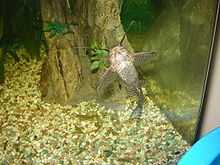Featherfin squeaker
| Synodontis eupterus (featherfin synodontis) | |
|---|---|
 | |
 | |
| Conservation status | |
| Scientific classification | |
| Kingdom: | Animalia |
| Phylum: | Chordata |
| Class: | Actinopterygii |
| Order: | Siluriformes |
| Family: | Mochokidae |
| Genus: | Synodontis |
| Species: | S. eupterus |
| Binomial name | |
| Synodontus euptera Boulenger, 1901 | |
The featherfin squeaker (Synodontis eupterus) or Featherfin Synodontis is a species of Synodontis catfish. This species is found in the basins of the White Nile, Volta and Niger Rivers and the Chad Basin. Also known simply as featherfin catfish. Featherfin squeakers are called such due to their ability to make noises to communicate with one another and also for their high feather-like fin which is valued by many hobbyists. Wild specimens can grow to a length of 30.0 centimetres (11.8 in) SL. These fish are usually kept singly in aquaria due to their territorial and aggressive nature when they reach maturity.
In the aquarium
A brown squeaker swimming upside-down.
General information
Featherfin squeakers are very hardy and easy to care for, and are great additions to community tanks that house larger fish. Just like with any other bottom dwellers be sure not to overcrowd as this may result in territorial disputes. The addition of caves and branched driftwood will allow for more patrol surfaces and several featherfin can be housed together. As with any fish, the tank water should always be clean and at a balanced pH (7-8.5), kH of 2–15 and a warm water temperature, around 25 to 28 degrees Celsius (77 to 82 °F). The absolute minimum tank size should be 30 gallons (110 L), with some large enough caves for the synodontis to hide in. Sometimes, like its cousin the Upside Down Catfish (Synodontis nigriventris), it may turn upside down in order to get food. This will usually only happen when it is resting.
Diet
These are omnivorous and should be given a good quality flake food as the staple, or sinking catfish pellets. An occasional feeding of spirulina flakes or algae wafers would ensure the vegetable part of their diet. Once weekly feeding of bloodworms, tubifex, brine shrimp and other meaty foods will complete the perfect diet. They should be fed just before the lights are turned off, because, like most catfish, it is nocturnal.
Tankmates
These bottom dwelling Synodontis catfish should have their own territories. Reports have been made that it is kept successfully with Corydoras Catfish, Plecostomus, Geophagus, Gouramis, and is said to be a perfect bottom dweller for rift lake cichlid aquariums. In some african cichlid tanks the other inhabitants may nibble the long dorsal streamers of the catfish.
Breeding
Synodontis eupterus has never been bred naturally in captivity, so there is a likelihood that pet shop specimens were bred from hormone injected parents, which is not readily available or recommended for an inexperienced hobbyist to accomplish.
References
- http://www.aquahobby.com/gallery/e_feather.php
- http://www.aquariumlife.net/profiles/african-catfish/featherfin-catfish/100062.asp
- Froese, Rainer and Pauly, Daniel, eds. (2011). "Synodontis euptera" in FishBase. December 2011 version.
- http://www.planetcatfish.com/common/species.php?species_id=121
External links
| Wikimedia Commons has media related to Synodontis eupterus. |


.jpg)